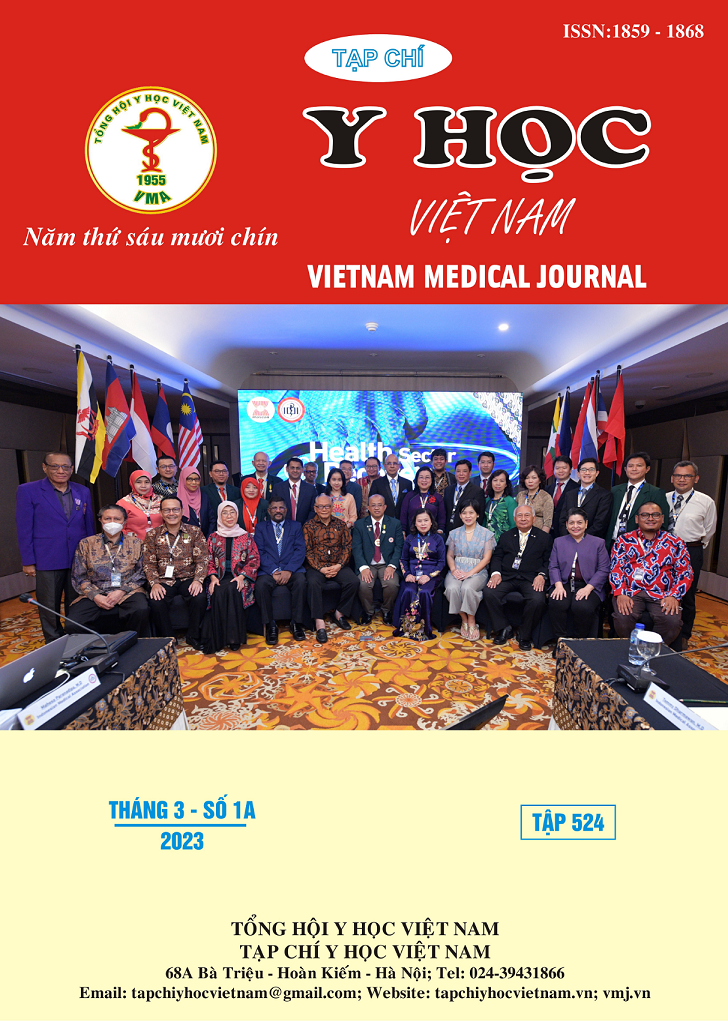COMPLIANCE WITH SAFETY PROCEDURE FOR GASTROSCOPY BY MEDICAL STAFFS AT DEPARTMENT OF IMAGE DIAGNOSTIC – PATHOLOGICAL ANATOMY, VINH TUONG DISTRICT HEALTH CENTER, VINH PHUC PROVINCE IN 2022
Main Article Content
Abstract
Objectives: To describe the current status of compliance with safety procedure for Gastroscopy by medical staffs in Image Diagnostic - Pathology Department at Vinh Tuong District Medical Center, Vinh Phuc Province, in 2022. Methodology: Cross-sectional descriptive study, combining quantitative and qualitative analysis in 90 gastroscopy cases from July 2022 to October 2022. Results: The overall compliance rate of medical staffs for all 3 stages of the Gastroscopy procedure was 78.9%. The highest compliance rate was at the endoscopy stage with 95.56%; the lowest was at the subsequent stage after the procedure with 87.8%. Regarding compliance rate of safety procedure at all 3 stages of 3 medical staff groups: the highest complication rate was the medical doctor group with 94.44%; the technician group had the lowest compliance rate with 84.44%. Some criteria of the endoscopic safety procedure checklist had low compliance rates such as "Check the endoscope before performing the endoscopy" (compliance rate is 93.33%); “Clean the endoscope and accessories in an enzymatic cleaning tank” (compliance rate is 90%). Conclusion: The overall compliance rate of medical staffs for all 3 stages of the Gastroscopy procedure was quite high. However, there still existed a low rate of non-compliance process. Therefore, medical staffs need to raise their sense of responsibility to ensure procedure safety in the 3 stages of gastroscopy, especially improvement in instructing patients on necessary information after endoscopy and handling endoscope equipment.
Article Details
Keywords
Procedure safety, medical staff, gastroscopy, patients
References
2. Bộ Y tế (2017), Hướng dẫn xử lý ống nội soi mềm trong các cơ sở khám bệnh, chữa bệnh, Ban hành kèm theo Quyết định số 3916/QĐ-BYT ngày 28/8/2017 của Bộ trưởng Bộ Y tế.
3. Cục Quản lý Khám chữa bệnh. Tài liệu đào tạo liên tục An toàn người bệnh: Nhà xuất bản Y học; 2014.
4. Phạm Văn Độ (2020), Thực trạng tuân thủ quy trình an toàn thủ thuật và một số yếu tố liên quan của nhân viên y tế tại bệnh viện Da liễu Trung ương năm 2020. Luận văn cao học, Trường Đại học Y tế Công cộng.
5. Đào Văn Long, Hoàng Anh Tú và cộng sự (2013), “Hiệu quả của phương pháp khử khuẩn ống nội soi mềm bằng máy tạo OZONE IHI và dung dịch khử khuẩn mức độ cao CIDEX OPA tại Bệnh viện Đại học Y Hà Nội”, Tạp chí Y học thực hành, 8 (878), tr.94-97.
6. Lê Thị Anh Thư (2017), “Cập nhật hướng dẫn xử lý dụng cụ thủ thuật nội soi”, Thời sự y học 12/2017, tr.5-9.
7. Robertson P et al. (2017), “Transmission of Salmonella enteritidis after endoscopic retrograde cholangiopancreatography because of inadequate endoscope decontamination”, Am J Infect Control, 45(4), p.440-442.
8. Stephanie J. PhD; Sevdalis Russ, Nick PhD; Moorthy, Krishna MD, FRCS; Mayer, ErikK.PhD, FRCS; Rout, Shantanu MRCS; Caris, JochemMD; Mansell, Jenny MSc; Davies, Rachel BA; Vincent, Charles PhD; Darzi, Ara MD, FACS (2015) “A Qualitative Evaluation of the Barriers and Facilitators Toward Implementation of the WHO Surgical Safety Checklist Across Hospitals in England: Lessons From the “Surgical Checklist Implementation Project”“. Annals of Surgery, 261 (1),81-91.


